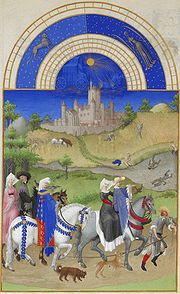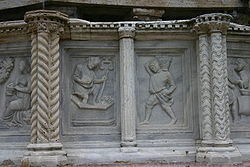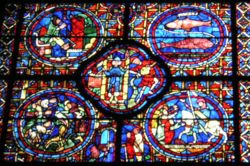
Labours of the Months
Encyclopedia

Medieval art
The medieval art of the Western world covers a vast scope of time and place, over 1000 years of art history in Europe, and at times the Middle East and North Africa...
and early Renaissance art depicting in twelve scenes the rural activities that commonly took place in the months of the year. They are often linked to the signs of the Zodiac
Zodiac
In astronomy, the zodiac is a circle of twelve 30° divisions of celestial longitude which are centred upon the ecliptic: the apparent path of the Sun across the celestial sphere over the course of the year...
, and are seen as humankind's response to God's ordering of the Universe.
The Labours of the Months are frequently found as part of large sculptural schemes on churches, and in illuminated manuscripts, especially in the Calendars of late medieval Books of Hours
Book of Hours
The book of hours was a devotional book popular in the later Middle Ages. It is the most common type of surviving medieval illuminated manuscript. Like every manuscript, each manuscript book of hours is unique in one way or another, but most contain a similar collection of texts, prayers and...
. The manuscripts are important for the development of landscape painting, containing most of the first painting where this was given prominence. The most famous cycle is that painted in the early 15th century by Hermann, Pol and Johan de Limbourg
Limbourg brothers
The Limbourg brothers, or in Dutch Gebroeders van Limburg , were famous Dutch miniature painters from the city of Nijmegen. They were active in the early 15th century in France and Burgundy, working in the style known as International Gothic...
in Tres Riches Heures du Duc de Berry
Très Riches Heures du Duc de Berry
The Très Riches Heures du Duc de Berry or simply the Très Riches Heures is a richly decorated book of hours commissioned by John, Duke of Berry, around 1410...
. In the 16th century, late in the history of the theme, Simon Bening
Simon Bening
Simon Bening was a 16th century miniature painter of the Ghent-Bruges school, the last major artist of the Netherlandish tradition....
produced especially fine cycles which link the Limbourgs with the landscape paintings of Peter Breughel the Elder.
Typical cycle
The contents of cycles varied with date, location, and the purpose of the work. The Tres Riches Heures du Duc de BerryTrès Riches Heures du Duc de Berry
The Très Riches Heures du Duc de Berry or simply the Très Riches Heures is a richly decorated book of hours commissioned by John, Duke of Berry, around 1410...
(illustrated right) was designed for the personal use of a great magnate, and was unusually large, allowing all the typical elements to be used in many months. It combines astrological and calendar information at the top, with a combination of the agricultual life of the peasant, the life of the elite courtiers, and illustrations of the Duke's many castles in the background of several scenes.
A typical simple scheme was:
- January - Feasting
- February - Sitting by the fire
- March - Pruning trees, or digging
- April - Planting, enjoying the country or picking flowers
- May - Hawking, courtly love
- June - Hay harvest
- July - wheat harvest
- August - wheat threshing
- September - Grape harvest
- October - ploughing or sowing
- November - gathering acorns for pigs
- December - killing the pig, baking bread
- but there were many variations, especially in major wine-growing areas, where more wine related scenes were included. Italian cycles often advance the agricultural scenes a month earlier than ones from the Low countries
Low Countries
The Low Countries are the historical lands around the low-lying delta of the Rhine, Scheldt, and Meuse rivers, including the modern countries of Belgium, the Netherlands, Luxembourg and parts of northern France and western Germany....
or England. The impact of the onset of the Little Ice Age
Little Ice Age
The Little Ice Age was a period of cooling that occurred after the Medieval Warm Period . While not a true ice age, the term was introduced into the scientific literature by François E. Matthes in 1939...
has been detected in differences between early and late examples.
Sculpture cycles

Archivolt
An archivolt is an ornamental molding or band following the curve on the underside of an arch. It is composed of bands of ornamental moldings surrounding an arched opening, corresponding to the architrave in the case of a rectangular opening...
of a portal, consist of an astrological symbol beside, above or incorporated in a sculpture or relief illustrating a monthly labour.
A few sculpted examples of the many surviving are:
- Chartres cathedral: west and north portal archivolts. Window, see below
- Notre Dame, Paris: northern door jambs of the west facade (Portal of the Virgin), and a stained glass Zodiacs, labours, vices and virtues cycle filling the west rose window
- VezelayVézelayVézelay is a commune in the Yonne department in Burgundy in north-central France. It is a defendable hill town famous for Vézelay Abbey. The town and the Basilica of St Magdelene are designated UNESCO World Heritage sites....
(Burgundy, Basilique Ste-Madeleine): Archivolt of main west basilica doorway - AutunAutunAutun is a commune in the Saône-et-Loire department in Burgundy in eastern France. It was founded during the early Roman Empire as Augustodunum. Autun marks the easternmost extent of the Umayyad campaign in Europe.-Early history:...
(Burgundy, Cathedral St-Lazare) : Archivolt of main west cathedral doorway - Ferrara CathedralFerrara CathedralFerrara Cathedral is a basilica in Ferrara, Northern Italy, the largest religious edifice in the city...
- Saint Mark's, Venice: main portal
- San Zeno di Verona: facade
- Lucca Cathedral: large bas-relief panels with little Zodial signs, to the right and left of the main facade door
- PerugiaPerugiaPerugia is the capital city of the region of Umbria in central Italy, near the River Tiber, and the capital of the province of Perugia. The city is located about north of Rome. It covers a high hilltop and part of the valleys around the area....
(Umbria) - Fontana Maggiore: relief panels showing monthly labours are amongst those surrounding the lower basin of the great fountain in front of the Duomo. - OtrantoOtrantoOtranto is a town and comune in the province of Lecce , in a fertile region once famous for its breed of horses.It is located on the east coast of the Salento peninsula. The Strait of Otranto, to which the city gives its name, connects the Adriatic Sea with the Ionian Sea and Italy with Albania...
(Apulia, cathederal): Zodiac signs and labours form part of the mosaic scenes which cover the entire floor. - Canterbury CathedralCanterbury CathedralCanterbury Cathedral in Canterbury, Kent, is one of the oldest and most famous Christian structures in England and forms part of a World Heritage Site....
: Zodiac signs and monthly labours are amongst the subjects illustrated in large inlaid marble floor medallions on the edge of the Trinity Chapel close to where the shrine of Saint Thomas (Becket) was located. - St Augustine's Church, Brookland, Kent: large cylindrical lead font with reliefs of both Zodiac signs and monthly labours - a rare example in the UK both of such a font and of the combination of zodiac signs and monthly labours.
- Carlisle CathedralCarlisle CathedralThe Cathedral Church of the Holy and Undivided Trinity, otherwise called Carlisle Cathedral, is the seat of the Anglican Bishop of Carlisle. It is located in Carlisle, in Cumbria, North West England...
: the foliate capitals of the twelve piers of the choir each contain a figure representing one of the labours of the months.
Stained glass

Rose window
A Rose window is often used as a generic term applied to a circular window, but is especially used for those found in churches of the Gothic architectural style and being divided into segments by stone mullions and tracery...
s that are dedicated to the Creation, the circular nature of the window suiting the cyclic theme. In these windows, the months are part of a complex iconographical scheme. Other windows have the Labours of the Months specifically as their subject matter.
- Basilica of Saint Denis : rose window of Creation, north transept rose See here :Image:St Denis North a.jpg
- Chartres Cathedral : "Labours of the Months" window in south ambulatory
External links
- Podtours site with info and many images
- Illuminated manuscript examples from the Museum of the Book, The Hague
- Photos of Zodiac and Monthly Labour Imagery in the churches of Britain, France and Italy
- The Medieval Year: Zodiac Signs and the Labors of the Months
- A comprehensive collection of images at „flickr“

